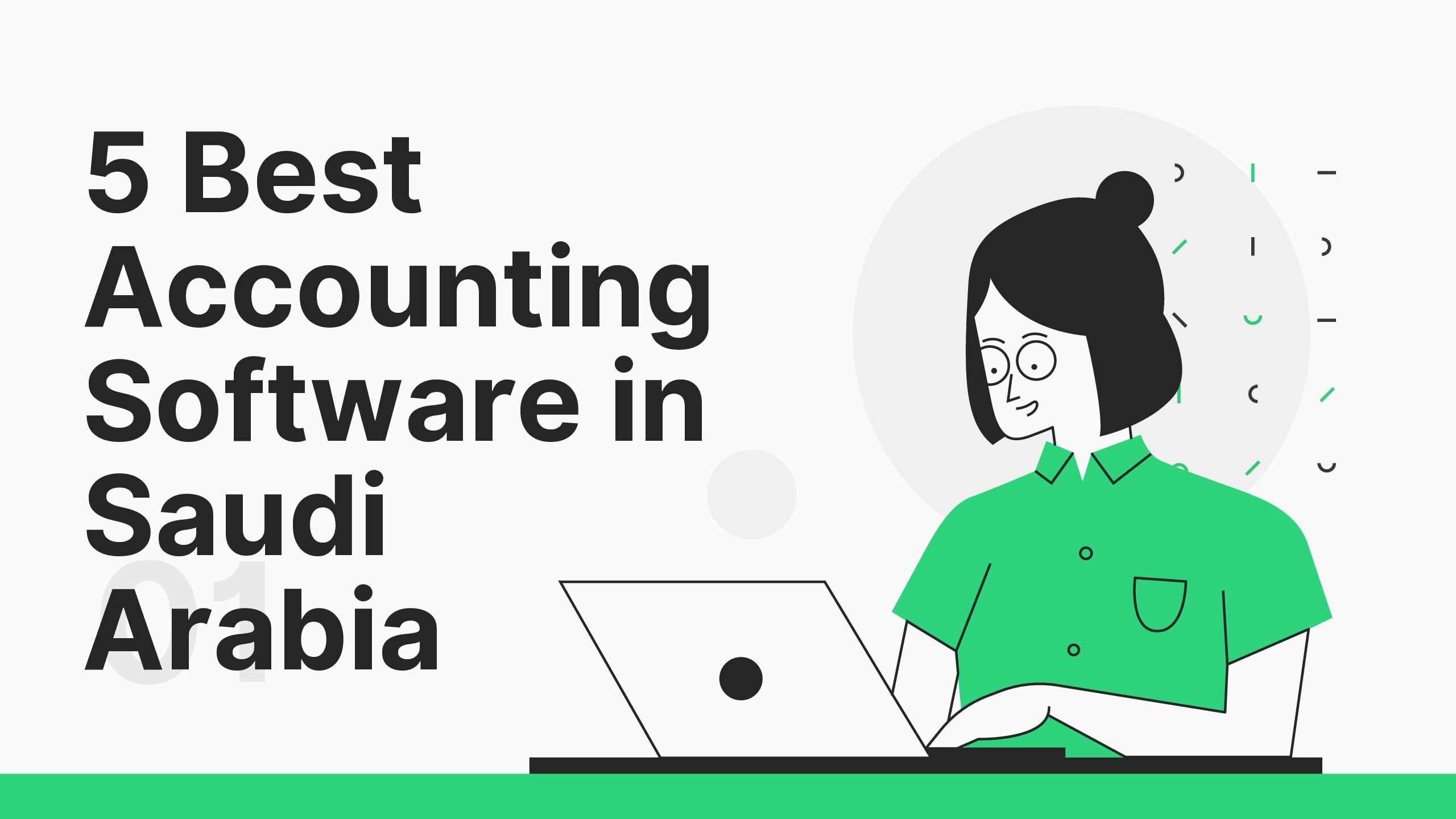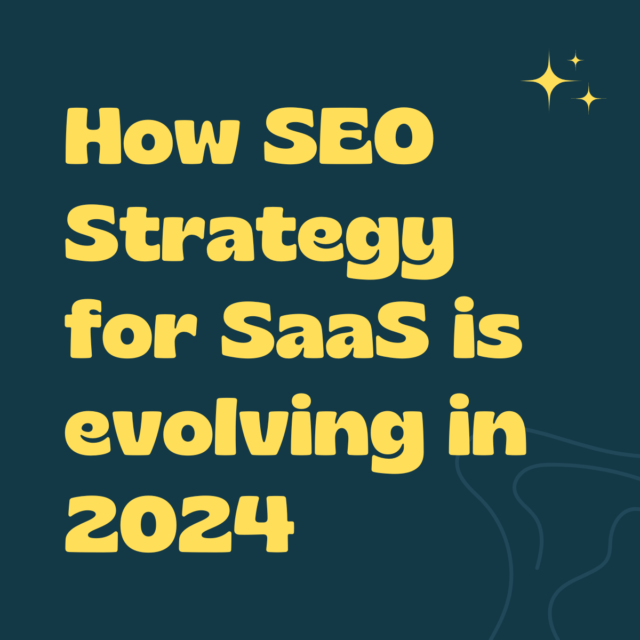In the competitive realm of SaaS SEO, breaking away from rigid norms can be a superpower. Traditional SEO practices are often treated as a standard booklet, but the reality is that SEO isn’t a one-size-fits-all checklist. While these practices have their place, they can also lead to resource wastage if followed blindly.
In this SaaS SEO guide, I’ll delve into the nuances of SEO strategy for SaaS and explore when it’s not just acceptable but strategic to challenge the conventional wisdom.
With the average company spending up to $180,000 per annum on thought leadership SaaS SEO no wonder there is so much attention on how to get your strategy right.
Key Takeaways
- Technical SEO audits are not always necessary; strategic omission can save resources and focus efforts where they’re most impactful.
- Optimizing for Core Web Vitals should be balanced with user experience and content quality, rather than being a default priority.
- Alt tags, while beneficial for accessibility and SEO, may not always be essential, and their use should be contextually determined.
- Content length should be dictated by quality and user engagement rather than adherence to an arbitrary word count.
- Keyword research should go beyond just volume and difficulty metrics to also consider user intent and the storytelling aspect of content.
The Myth of the Technical SEO Audit
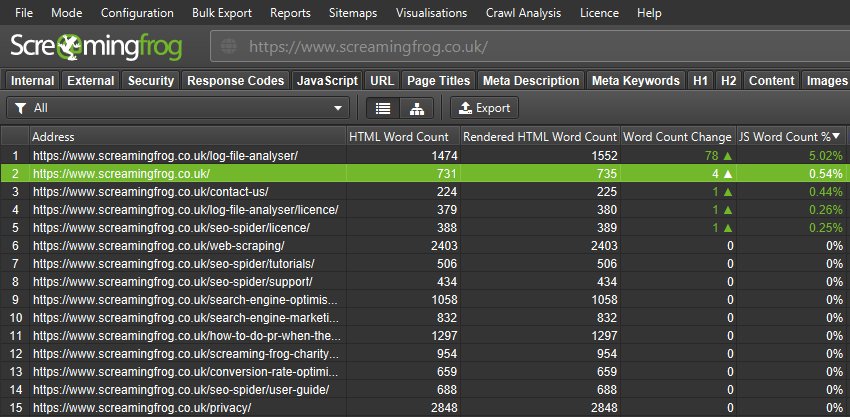
Questioning the Necessity of Tech Audits
In the fast-paced world of SaaS SEO, the technical SEO audit has been hailed as an indispensable tool. Yet, it’s crucial to question the necessity of these audits in every scenario. Not all SaaS companies may need to undergo a comprehensive tech audit, especially if they are startups or have limited resources.
- Resource Allocation: Consider the cost-benefit ratio of a tech audit.
- Immediate Needs: Address urgent SEO issues without a full audit.
- Strategic Planning: Use audits selectively to inform long-term strategy.
Deciding to skip a technical audit should not be taken lightly, but there are circumstances where the resources could be better spent on direct SEO actions or content development.
By carefully assessing the specific needs and goals of your SaaS business, you can make an informed decision on whether to conduct an audit or allocate resources elsewhere.
When Skipping an Audit Can Be Strategic
In the dynamic world of SaaS SEO, not every situation warrants a technical SEO audit.
There are instances where the resources typically allocated for an audit can be more strategically deployed elsewhere. For example, if a SaaS company has recently undergone a comprehensive audit and implemented significant changes, it may be more beneficial to monitor the impact of those changes before investing in another audit.
- Prioritizing impactful changes: Focus on implementing recommendations from previous audits before conducting new ones.
- Resource optimization: Allocate resources to areas with higher ROI potential, such as content creation or user experience improvements.
- Agility in SEO strategy: Adapt quickly to market changes without being bogged down by frequent audits.
All you need is an SEO tool like SEMRush, Ahrefs and Screaming Frog to look at your website’s current traffic.
Compare how much your traffic changed over time versus pages published.
Attempt to understand why you might not be getting the expected growth or why your content is not ranking.
Start by using the current traffic to find and address technical issues.
Analyze how well your existing content is performing.
Update or delete content as needed, and use 301 redirects when necessary.
Finally, conclude the audit by identifying new opportunities.
Balancing Technical Needs with Resource Allocation
In the world of SaaS SEO, it’s essential to understand that not all technical investments produce the same outcomes. Finding the right equilibrium between SEO’s technical aspects and resource allocation is a nuanced process crucial for determining the success of your strategy. It involves identifying where to allocate your time and financial resources to maximize returns.
- Evaluate the potential impact of technical changes on SEO performance.
- Consider the resources available, including budget and team expertise.
- Prioritize technical fixes that align with business goals and user experience.
The finance divide and the need for cross-functional collaboration highlight the importance of integrating SEO considerations into broader business strategies. By doing so, you can ensure that your technical SEO efforts are not only effective but also sustainable in the long term.
Core Web Vitals: Not Always a Priority

Understanding When to Optimize Core Web Vitals
In the dynamic landscape of SaaS SEO, not all websites will benefit equally from optimizing Core Web Vitals.
It’s essential to assess whether the potential gains in search ranking justify the investment of time and resources. For some sites, especially those with a strong brand presence or a niche audience, the user experience may already be satisfactory, and the marginal improvements in speed or stability may not translate into significant SEO gains or user satisfaction.
- Evaluate the current performance and user feedback.
- Consider the industry standards and competitor benchmarks.
- Analyze the cost-benefit ratio of potential optimizations.
Ultimately, the decision to optimize should be driven by strategic goals and a clear understanding of how Core Web Vitals impact your specific audience.
If the analysis shows that your users highly value speed and stability, then prioritizing these metrics can lead to a competitive edge. However, if your audience places more weight on content richness and relevance, it may be wise to allocate resources accordingly.
The Impact of User Experience vs. Technical Metrics
When it comes to SaaS SEO, it’s like a tug-of-war between user experience (UX) and technical metrics—it’s a real back-and-forth. But here’s the thing: while nailing the technical stuff is important, focusing on giving users a great experience often wins out in keeping them around and getting those conversions.
While technical SEO lays the groundwork for search engines to crawl and index a site effectively, it’s the UX that ultimately keeps users engaged.
- Technical SEO is about making your site accessible to search engines.
- UX focuses on the human side, ensuring the site is intuitive and enjoyable for visitors.
Balancing these aspects requires a nuanced approach, where decisions are driven by the specific goals and context of your SaaS offering. It’s not just about following a checklist; it’s about understanding the impact of each element on the user journey and business objectives.
Prioritizing Content Over Technical Perfection
In the world of SEO strategy for SaaS, it’s common to get hyper-focused on the technical side of things, aiming for perfection in every metric. However, let’s not overlook the vital role of content—it’s the heart of your SEO strategy, not just an add-on to technical tweaks. So, while we’re fine-tuning those technical bits, let’s make sure our content shines just as bright, shall we?
The true measure of a site’s value is in its ability to engage and convert visitors, which is primarily driven by the quality and relevance of its content.
- Content must resonate with your audience.
- It should solve problems or answer questions.
- Originality can set you apart from competitors.
Remember, a technically flawless site with mediocre content will struggle to retain visitors. Conversely, a site with exceptional content can often overcome technical shortcomings.
It’s about striking a balance, ensuring that your content marketing efforts are not overshadowed by an overemphasis on technical perfection.
In addition, a common challenge that SaaS businesses face is that they don’t get leads and sales through their SEO & Content Marketing efforts.
Here is how you can align your content with your marketing goals to get those previous leads.
Problem-Solving Blog Posts
These directly address customer pain points, and your product becomes the solution. By establishing your expertise, you earn trust and attract those actively searching for answers.
Case Studies
Success stories are powerful social proof. They detail how your SaaS solved real-life problems, giving prospects a clear picture of potential benefits. (Effective on your website and repurposed on social media)
Product Demos
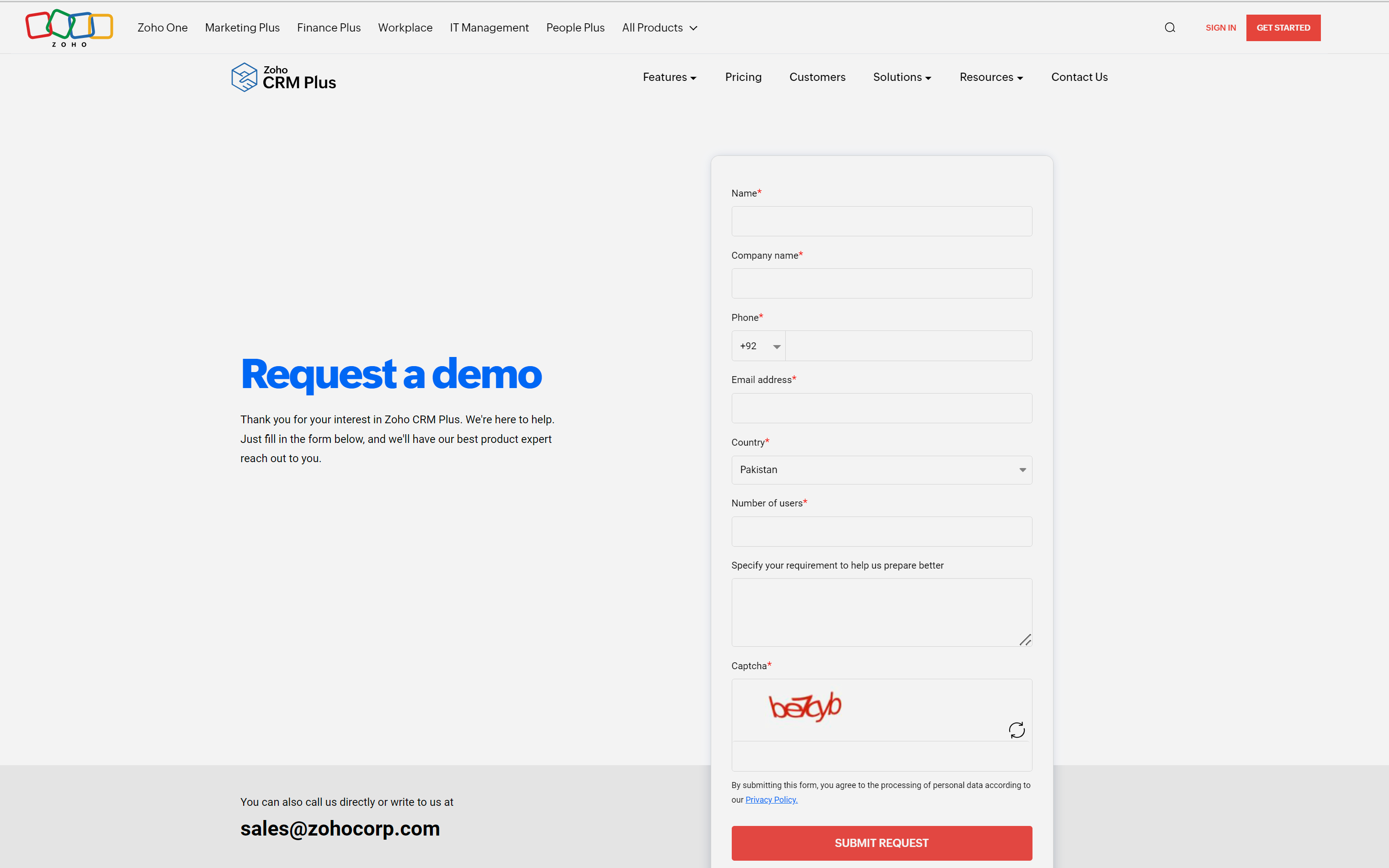
Clear, concise videos showcasing your product in action. These cater to visual learners and address questions faster than text.
Customer Testimonials
Short, authentic quotes or videos directly from happy customers. These build more trust than you could say about yourself!
The Alt Tag Debate: To Tag or Not to Tag
Evaluating the Real SEO Benefits of Alt Tags
The debate around alt tags and their SEO value is ongoing, with some webmasters swearing by their efficacy and others viewing them as an afterthought. Alt tags serve as text alternatives for images, aiding in accessibility and providing context to search engines. However, their direct impact on SEO rankings is often overstated.
- Accessibility: Ensures that screen readers can describe images to visually impaired users.
- Context: Offers search engines clues about the subject matter of the image.
- Relevance: This may contribute to the overall relevance of the page for certain queries.
In practice, alt tags should be used judiciously.
Over-optimization or keyword stuffing in alt attributes can lead to a negative user experience and potentially harm SEO efforts. Instead, focus on creating alt text that is descriptive and genuinely helpful for both users and search engines.
When Alt Tags Can Be Overlooked
In the vast landscape of SEO, alt tags have been a staple for ensuring images are accessible and indexable by search engines. However, there are scenarios where the meticulous crafting of alt text for every image may not be the best use of resources.
When images are purely decorative and contribute no additional information, alt tags can be safely deprioritized without a significant impact on SEO.
- Decorative images that serve as background elements or design flourishes
- Images that are repetitive and convey the same content as nearby text
- When images are part of a gallery where the main content is described elsewhere
While alt tags play a crucial role in accessibility, their SEO benefits can be nuanced. In cases where images do not add substantive content or context, the return on investment for creating detailed alt text diminishes. It’s about striking a balance between the practicality of alt text and the overall goals of your SEO strategy.
Striking a Balance Between Accessibility and SEO
In the quest for search engine dominance, it’s easy to forget that SEO and accessibility should work hand in hand. A site that ranks well but isn’t accessible misses out on a significant audience segment. Conversely, a highly accessible site that doesn’t rank fails to reach its potential visitors. Here’s how to strike a balance:
- Prioritize clear, descriptive alt tags that serve both screen readers and SEO by providing context.
- Use semantic HTML to enhance both SEO and accessibility, as search engines and assistive technologies rely on it to understand content structure.
- Test with real users, including those with disabilities, to ensure that SEO enhancements don’t impede usability.
Remember, the goal is to create a website that is not only discoverable but also usable by everyone. By considering both SEO and accessibility from the start, you can build a site that truly stands out in the digital landscape.
Content-Length: Breaking the Word Count Rules
Quality Over Quantity: The Case for Conciseness
In the sphere of SaaS SEO strategy, the principle of ‘less is more’ holds significant weight. Embracing conciseness in content creation transcends mere stylistic preference; it’s a strategic imperative. By distilling information to its essence, businesses can more effectively captivate their audiences, ensuring that each word serves a distinct purpose and delivers tangible value.
Here’s why conciseness matters:
- It respects the reader’s time, providing them with the information they need without unnecessary filler.
- Clear and concise content is more likely to be read and shared, increasing its reach and effectiveness.
- Search engines value content that satisfies user intent without being overly verbose, which can improve rankings.
While the temptation to equate length with thoroughness is common, it’s essential to remember that a focused message can be more powerful than a lengthy dissertation. The key is to tailor your content to your audience’s needs and the purpose of your message, not to an arbitrary word count.
The Myth of the ‘Ideal’ Content-Length
The quest for the ‘perfect webpage‘ is a common pursuit in SEO, but it’s a myth that there’s a one-size-fits-all content length that guarantees success. Content should be as long as it needs to be to serve its purpose, whether that’s to inform, entertain, or convert. Here are some considerations to keep in mind:
- Audience Expectations: Different audiences have different expectations. A technical audience might appreciate detailed, long-form content, while a general audience might prefer quick reads.
- Content Goals: The goal of your content should dictate its length. Educational pieces might need more elaboration, whereas a product announcement might be brief and to the point.
- Search Intent: Matching the search intent of your users can often mean varying the length of your content. Some queries are best answered with short, concise answers, while others require in-depth exploration.
Remember, the value of content is not measured in words but in the relevance and clarity of the information provided. The ‘ideal’ content length is a flexible concept that should adapt to the context of the content and the needs of the user.
Tailoring Word Count to Audience and Purpose
When it comes to content length, it’s not just about hitting a word count—it’s a strategic game plan. Picture this: your audience craves insightful content tailored to their needs. Think of your content like a toolbelt. You’ve got your heavy-duty technical whitepapers for in-depth exploration and your sleek blog posts for quick, engaging insights. It’s all about understanding your audience’s hunger for knowledge and serving it up just right.
- Technical Whitepaper: In-depth analysis, comprehensive coverage
- Blog Post: Quick insights, engaging storytelling
- Product Description: Concise benefits, clear features
Understanding the context in which your content will be consumed is crucial. A user seeking quick tips will appreciate a short, to-the-point article, while someone researching a complex topic expects detailed, long-form content. Tailoring your word count to these expectations not only improves user experience but also aligns with search engines’ growing emphasis on content quality and relevance.
Keyword Research: Beyond Volume and Difficulty

Challenging Traditional Keyword Metrics
Traditionally, we’ve leaned heavily on keyword metrics like volume and difficulty to steer our ship. But guess what? Times are changing, and so should we! Picture this: you’re navigating through a sea of high keyword competition and intricate websites—talk about a challenge! Relying solely on metrics might not cut it anymore. It’s time to steer our strategy towards a more nuanced approach, one that takes into account the ever-evolving landscape of SEO for enterprise SaaS.
- Volume may indicate popularity, but not necessarily conversion potential.
- Difficulty scores can deter from targeting niche, yet valuable audiences.
- Relevance and user intent are becoming paramount in keyword selection.
By integrating qualitative insights with quantitative data, we can craft strategies that resonate more deeply with our target audience.
This means looking beyond the numbers to understand the context and the specific challenges that SaaS companies face, such as complex websites that make technical SEO difficult. It’s about finding the balance between what the data suggests and what the user actually needs.
Focusing on Intent Rather Than Numbers
It’s easy to get caught up in the numbers game—tracking keyword volume and difficulty as if they were the sole indicators of success.
However, focusing on the searcher’s intent is often a more strategic approach.
By understanding the ‘why’ behind a search query, businesses can create content that truly resonates with their audience, leading to better engagement and conversion rates.
- Understand the user’s problem or need
- Consider the stage of the buyer’s journey
- Align content with user expectations
This shift in perspective requires a nuanced understanding of your audience. It’s about digging deeper into the context of searches and crafting solutions that are not just found, but also valued. By doing so, you can transcend the limitations of traditional metrics and foster a more meaningful connection with your users.
Innovative Approaches to Keyword Selection
In the ever-evolving landscape of SaaS SEO, traditional keyword selection methods are being supplemented with innovative strategies.
Embracing a holistic approach to keyword research involves understanding the nuances of your audience’s language and the context in which they seek solutions.
- Ideation based on customer value propositions can uncover unique keyword opportunities that align with what your audience truly values.
- Leveraging cutting-edge tools like ChatGPT4 for SEO can provide insights into conversational queries and long-tail phrases that are becoming increasingly relevant.
- Multivariate testing for online product pricing can also inform keyword selection, as it highlights the terms that resonate with customers willing to make a purchase.
By integrating these innovative methods, brands can craft a keyword strategy that not only improves rankings but also fosters a deeper connection with their audience.
The Best 13 SaaS Keyword Research Methods for 2024 by MADX suggests that ranking first on Google requires more than just content; it demands a strategic approach to keyword research.
Title Tags: The Exact Match Conundrum
The Overemphasis on Exact Match Keywords
The focus on exact-match keywords has been a longstanding practice, often overshadowing the importance of context and relevance.
Marketers have been conditioned to chase the ‘perfect’ keyword match, believing it to be the key to ranking success. However, this approach can lead to content that feels forced or unnatural, ultimately detracting from the user experience.
- The pursuit of exact matches can stifle creativity.
- It may result in keyword-stuffed content that repels users.
- Search engines are evolving to prioritize user intent over rigid keyword matching.
It’s essential to strike a balance where keywords enhance rather than dominate the narrative. By doing so, brands can create content that is not only SEO-friendly but also engaging and valuable to the reader.
Creativity and Click-Worthiness vs. Exact Matches
There’s a delicate balance between adhering to best practices and embracing the art of creativity.
The overemphasis on exact match keywords can stifle the potential for a title tag to captivate and engage.
While exact match targets search queries that are the same as the keyword or very closely related variations, it’s not the only path to visibility and click-throughs.
Understanding the audience’s intent and interests allows for a more nuanced approach to title tags. Here’s a simple list to consider when evaluating title tag strategies:
- Reflect the page content accurately, but with a creative twist
- Use synonyms and related phrases to broaden the reach
- Incorporate brand voice and personality
- Test different variations to see what resonates best with users
Ultimately, a title tag should be a harmonious fusion of SEO best practices and the unique voice of the brand, ensuring that it not only ranks well but also entices users to click.
When to Prioritize Branding Over Keywords
There comes a time when branding must take precedence over keyword optimization. This strategic shift is crucial for businesses aiming to establish a unique identity and foster long-term customer loyalty.
- Brand differentiation is key to standing out in a crowded market.
- A strong brand can serve as a competitive advantage, often more so than ranking for high-volume keywords.
- Prioritizing brand messaging aligns design and content, creating a cohesive user experience.
Decisions should be driven by the brand’s core values and the unique value proposition it offers to customers. While SEO tactics are important, they should not overshadow the brand’s narrative. Remember, a well-crafted brand story can engage and convert customers even without relying on high-ranking keywords.
Traffic Drops: Not Always a Red Flag
Analyzing Traffic Drops with a Critical Eye
When faced with a sudden drop in website traffic, it’s crucial to perform a technical SEO analysis. This step is essential to uncover any underlying issues that may have caused the decline. However, it’s important not to jump to conclusions or rush into hasty fixes without a thorough investigation.
Consider the following points when analyzing traffic drops:
- Review recent changes to your website that could have impacted visibility.
- Assess the competitive landscape to determine if new players or updates have influenced your rankings.
- Examine industry trends to identify if the drop is part of a larger pattern affecting similar businesses.
Remember, not all traffic drops signal an SEO crisis. Sometimes, they can be attributed to natural market fluctuations or seasonal trends. It’s essential to approach each situation with a clear mind and a strategic plan.
Understanding Seasonality and Market Trends
Recognizing the ebb and flow of market demand is crucial for SaaS businesses.
Seasonal trends can significantly influence user behavior and, consequently, website traffic. By analyzing these patterns, companies can anticipate changes and adapt their strategies accordingly. For instance, a SaaS provider specializing in tax software will see a surge in traffic around tax season, while a vacation rental platform might peak during holiday months.
It’s important to remember that not all traffic drops are alarming.
Sometimes, they are just reflections of the market’s natural cycle. To illustrate, consider the following table showing hypothetical monthly traffic for a tax software company:
| Month | Traffic Volume |
|---|---|
| January | 10,000 |
| February | 15,000 |
| March | 25,000 |
| April | 30,000 |
| May | 5,000 |
| June | 3,000 |
This approach not only ensures that resources are allocated efficiently but also that content remains relevant and engaging year after year. It’s a strategic move that aligns with the natural rhythm of the market, rather than fighting against it.
When Less Traffic Can Mean More Quality
In SEO Strategy for SaaS, a dip in website traffic doesn’t necessarily spell disaster. A high bounce rate typically suggests that the website is not meeting visitor expectations or providing a positive user experience. By focusing on the quality of traffic rather than sheer numbers, companies can cultivate a more engaged and valuable user base.
Here are a few scenarios where less traffic can be more beneficial:
- When it leads to a higher percentage of targeted, high-intent visitors.
- If the traffic is more aligned with the company’s ideal customer profile.
- When it results in a lower bounce rate and longer session durations.
- If it increases the likelihood of visitors taking desired actions, such as signing up or making a purchase.
Analyzing and Diagnosing SaaS Organic Traffic Drops
Assessing Organic Search Traffic Changes with GA4
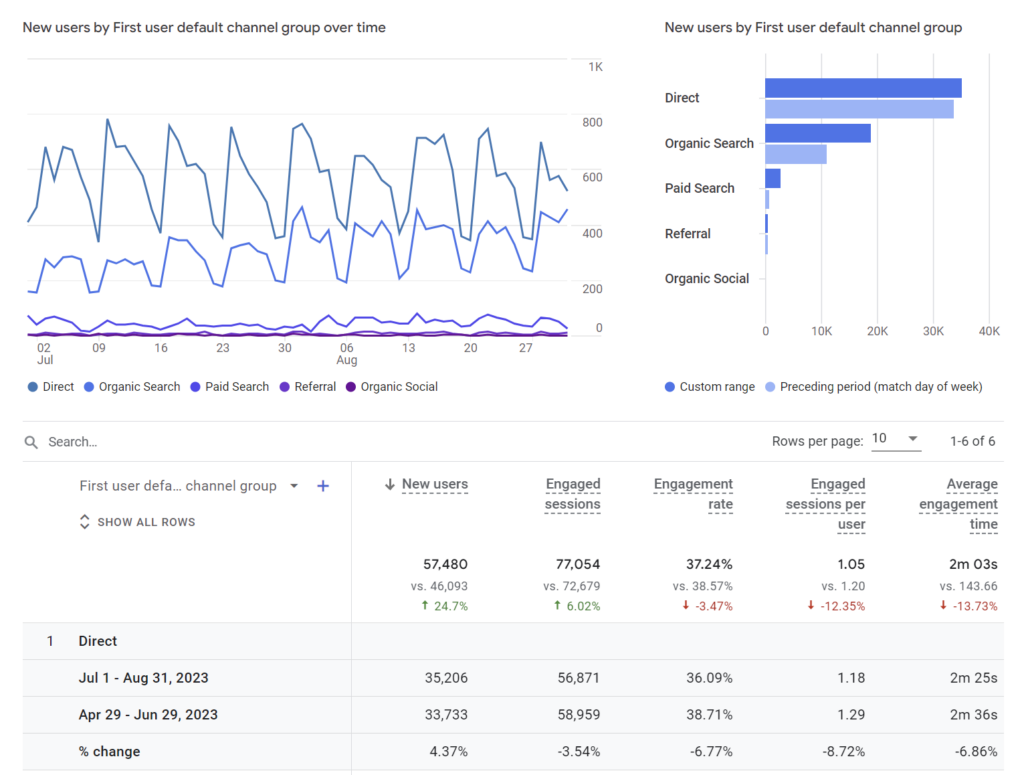
To understand shifts in organic search traffic, utilize GA4 to analyze fluctuations in “New Users” arriving through organic search. Access Reports → Acquisition → User Acquisition and select a date range comparison.
Interpreting Changes in Organic Traffic
Consider a scenario where a 20% decrease in organic traffic occurs between two months. Correlate this decline with reduced conversions to ascertain potential causes for the drop in leads.
Detailed Analysis with Google Search Console
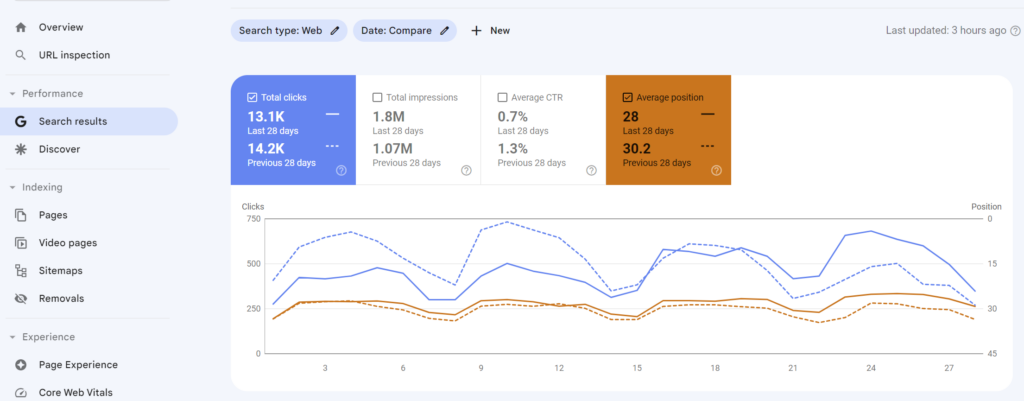
For a deeper examination, navigate to Google Search Console. Access Search Results → Select “Total clicks” and “Average position” → Define your date range.
Identifying Performance Discrepancies
Upon analysis, observe a decrease of approximately 1,100 clicks despite a slight improvement in the average ranking position. Proceed to scrutinize individual pages to diagnose the drop.
Filtering Page-Level Results
Refine the analysis by filtering page results based on Clicks Difference or Position Difference. Identify top-performing pages experiencing a decrease in clicks compared to the previous period.
Case Study: Investigating Page Performance
Examine the performance of specific pages to uncover potential causes for the decline:
- Page #1: Experienced a decline in positions, resulting in decreased clicks and traffic.
- Page #2 & Page #3: Sustained a drop in clicks despite maintaining relatively stable positions.
Diagnostic Inquiry
Delve into the following questions to understand the decline:
- Were any alterations made to the affected page?
- How can the page be enhanced to improve rankings?
- Is the content outdated compared to competing pages in the search results?
Resolution
In this scenario, outdated content on Page #1 contributed to its decline in search rankings. Addressing this issue through content updates and refreshes led to a resurgence in search visibility and traffic.
Tool Dependency: When to Ignore the SEO Software
The Dangers of Over-Reliance on SEO Tools
In the rapidly evolving landscape of SaaS Marketing SEO, it’s tempting to lean heavily on the latest tools and software. However, over-reliance on these tools can lead to a homogenized approach that fails to differentiate your SaaS offering. SEO tools often suggest similar keywords and strategies, which can result in a lack of content diversity and a sea of indistinguishable SaaS websites.
- SEO tools may not account for the unique context of your business.
- They can encourage a focus on metrics at the expense of user experience.
- Overuse can lead to keyword overreliance and ethical issues.
Remember, the goal is to stand out in the digital marketplace, not to blend in. Balancing the use of SEO tools with innovative, human-centric approaches will ensure your SaaS brand remains distinctive and engaging.
Using Tools as Guides
Tools are indispensable for providing insights and data-driven guidance. However, it’s crucial to remember that they are just that—tools. They should inform your strategy, not dictate it. SEO tools are adept at analyzing vast amounts of data, but they lack the nuance and understanding of a skilled SEO professional. It’s the human element that can interpret the subtleties of your specific market and audience needs.
- Use tools to identify trends and patterns.
- Analyze the data with a critical eye.
- Apply your unique business context to the insights.
Remember, no tool can replace the strategic thinking and creativity required to truly excel in SEO. Tools can lead you to water, but it’s your job to determine if it’s the right watering hole for your audience.
When Human Insight Trumps Algorithmic Advice
There’s a growing recognition that human insight is indispensable, even in an age dominated by sophisticated algorithms. While SEO tools provide valuable data, they lack the nuanced understanding that human experience brings to content creation and strategy. For instance, AI can suggest keywords, but only a human can weave them into a narrative that resonates with readers.
- Human-led content creation emphasizes storytelling over keyword density.
- Human insight can identify cultural nuances and audience preferences that algorithms miss.
- Strategic decision-making often requires a human touch to interpret data in context.
Business leaders and content creators must recognize when to step back from the data and trust their instincts. This is particularly true in complex scenarios where the subtleties of human behaviour and market trends are at play. By balancing algorithmic advice with human judgment, companies can craft SEO strategies that are not only data-driven but also deeply engaging and authentic to their brand voice.
Subdomain vs. Subfolder: The SEO Strategy for SaaS Dilemma
Debunking the Subdomain vs. Subfolder Myth
The debate between using subdomains or subfolders has long been a contentious topic in the SEO community. The truth is, there is no one-size-fits-all answer; the decision should be based on specific business needs and website goals.
For instance, subdomains can be beneficial when you want to clearly separate different sections of your business or offer distinct user experiences. However, subfolders are often recommended for their simplicity and potential SEO benefits, as they are seen as part of the main domain.
Subdomains may be suitable for:
-
- Brand divisions
- Different product lines
- Geographic or language-specific content
Subfolders are often chosen for:
-
-
- Blog or article sections
- Product categories
- Campaign-specific pages
-
Making Decisions Based on Your Unique Context
The choice between using a subdomain or a subfolder must be tailored to the specific needs and context of your SaaS business. Each option has its own set of advantages and trade-offs, and what works for one company may not be the best for another. Consider the following factors when making your decision:
- The structure of your website and how content is organized
- The authority of your main domain versus the potential of a subdomain
- How your users navigate and what provides the best user experience
- The resources available for managing and promoting separate domains or subdirectories
Remember, the decision should support your overall brand strategy and contribute to a cohesive user journey. While SEO implications are important, they should not overshadow the primary objective of serving your audience effectively.
The Role of Branding and User Experience in Structure Choices
The strategic balance between SEO and UX is paramount. User experience (UX) is not just a buzzword; it’s a critical component that shapes how customers interact with a brand. A well-structured website can enhance UX, leading to increased customer satisfaction and loyalty.
When considering whether to use a subdomain or subfolder, it’s essential to reflect on your brand’s unique narrative and how you want to be perceived. Brand differentiation often hinges on these structural decisions, as they can affect the user’s journey through your site.
- Brand Values: Align structure with what your brand stands for.
- User Journey: Ensure easy navigation that reflects your brand’s story.
- Consistency: Maintain a consistent experience across all platforms.
Communicating with Content Creators: Keywords Are Not Everything
Encouraging Storytelling Over Keyword Stuffing
In the domain of content creation, the shift from keyword density to storytelling marks a pivotal change in SEO strategies. The art of storytelling not only captivates the audience but also fosters a deeper connection with the brand. This approach aligns with the evolving algorithms that favour content resonating with human interests and experiences.
To embrace this shift, content creators should consider the following points:
- Crafting narratives that reflect the brand’s values and journey.
- Integrating customer testimonials and relatable experiences into the content.
- Using emotional appeal to engage and resonate with the audience.
By prioritizing these elements, we can create content that is both SEO-friendly and genuinely valuable to our readers. It’s about finding the balance between optimization and authenticity, ensuring that our content is not just found, but also loved and shared.
The Importance of Human-Centric Content
It’s easy to get caught up in the mechanics of optimization and forget the ultimate purpose of content: to engage and inform real people. The shift towards human-centric content is not just a trend, but a fundamental change in approach. This means crafting stories that resonate on a personal level, rather than merely serving as vessels for keywords.
- Focus on the reader’s experience and emotions
- Tell relatable stories that connect with your audience
- Use language that is natural and conversational
By prioritizing the human element, we create content that is not only more enjoyable to read but also more likely to convert. After all, a satisfied reader is more inclined to trust your brand, share your content, and return for more.
Guiding Writers Without Stifling Creativity
In the realm of SaaS SEO, the balance between guiding content creators and preserving their creative freedom is delicate. Outlining the structure of the content is a pivotal step that aids writers in understanding the intended message while minimizing constraints on their creativity. This approach not only clarifies the direction but also empowers writers to infuse their unique voices and perspective.
- Encourage exploration of new angles and ideas
- Provide clear objectives without dictating style
- Emphasize storytelling and audience engagement
By fostering an environment where creativity thrives, content creators can produce work that is both SEO-friendly and genuinely engaging. This synergy between creativity and SEO can lead to content that stands out in a crowded digital landscape.
It’s crucial to remember that while SEO principles are important, they should not overshadow the art of storytelling. Content that connects with the audience on a human level will always have a place, regardless of algorithmic changes. Therefore, it’s essential to guide writers with a light touch, allowing them the freedom to craft narratives that resonate deeply with readers.
Importance of Human-Led Content for SEO Strategy in SaaS
Content marketing is essential for businesses in today’s competitive digital landscape, offering a lifeline for staying relevant and thriving even during tough times.
Kyle Byers from Semrush emphasizes the importance of a human-centred approach to content creation to ensure brands’ voices are heard amidst the online noise. By building personal connections with customers and understanding their needs, businesses can drive meaningful engagement and long-term success.
Semrush’s recent content marketing survey highlights the opportunity for organic growth through SEO, social media, and video content, even amid anticipated slowdowns in advertising spending.
Ultimately, prioritizing authentic connection and strategic content creation enables businesses to thrive in the digital age, ensuring their message resonates with their audience. 🚀
Hot Tip: Poach your SaaS Competitor’s Conversions with SEO & Content Marketing
The Comparison Thief Strategy is a clever approach that transcends the traditional boundaries of SEO, transforming it into a potent demand generation engine. Instead of merely targeting existing search demand, this strategy allows businesses to tap into a pool of potential customers who may be considering their competitors.
Here’s how it works:
1) Identify Your Competitors: Start by compiling a list of the top competitors in your niche. These are the brands that your target audience is likely already familiar with.
2) Create Comparison Content: Develop articles that compare the most popular solutions within your industry, focusing on the brands of your competitors rather than your own. For example, if your brand is “Monday,” you might create content comparing “ClickUp vs Asana.”
3) Craft Compelling Titles and Hooks: Ensure that your article titles and hooks are attention-grabbing and relevant to your audience’s interests. Highlight key features or benefits that differentiate the products being compared.
4) Provide Genuine and Helpful Content: Test each product thoroughly and write from experience. Offer valuable insights and unbiased comparisons to help readers make informed decisions.
5) Promote Your Solution: At the end of the article, subtly introduce your own solution as the best alternative. Position your product or service as a compelling option that addresses any shortcomings identified in the comparison.
By implementing the Comparison Thief Strategy, businesses can achieve several key benefits:
1) Conversions from Competition: By strategically positioning your solution within comparison content, you can capture conversions from customers who were initially considering your competitors.
2) Leveraging High Branded Search Volume: By capitalizing on the high branded search volume of your competitors, even smaller players in the market can effectively compete and drive traffic to their own offerings.
In essence, this strategy allows businesses to provide genuinely helpful content to their audience while simultaneously promoting their own solution to potential customers who may not have been aware of them previously. It’s a win-win approach that can yield significant results in terms of traffic, conversions, and market share.
Bonus: 5 Tips for SaaS SEO with ChatGPT
I’ve added 5 bonus tips for using ChatGPT to fire up your SaaS SEO Strategy. Dive into keyword strategies, optimized meta descriptions, product page optimization, blog content strategy, and internal link building to supercharge your software’s online presence.
Keyword Strategies:
SaaS SEO is a pivotal element in scaling your software business.
Prompt 1: Browse the web and generate a list of SEO strategies tailored for SaaS businesses for your own website.
Example: Browse and generate a list of SEO keyword strategies tailored for SaaS businesses for “Cloudsolutions.com”.
Optimized Meta Descriptions:
Prompt 2: Browse the website and write compelling meta descriptions or 140-150 characters for SaaS products for (your website).
Example: Browse the website and write compelling meta descriptions or 140-150 characters for SaaS products for (project.com).
Product Page Optimization
Prompt 3: Browse these URLs and suggest optimizations for SaaS product pages for search engines (list of URLs).
Example: Browse these URLs and suggest optimizations for SaaS product pages for search engines (email.com/email-software).
Blog Content Strategy
Prompt 4: Browse the website and create a plan for leveraging blog content to improve SaaS SEO for (your website).
Example: Browse the website and create a plan for leveraging blog content to improve SaaS SEO for (crm.com).
Internal Link Building
Prompt 5: Browse the site and draft a guide on using internal linking effectively for SEO on your (website).
Example: Browse the site and draft a guide on using internal linking effectively for SEO on your (financetools.com).
Conclusion: Embracing the Art of SEO Rebellion
In the ever-evolving landscape of SaaS SEO, adhering strictly to conventional wisdom can sometimes be more of a hindrance than a help. Throughout this article, we’ve explored the nuances of when to follow the rules andZ when to boldly challenge them. As we’ve seen, SEO is not a one-size-fits-all checklist but an art that requires a deep understanding of context, audience, and objectives. From questioning the necessity of technical audits to rethinking content length and keyword usage, we’ve delved into the counterintuitive approaches that can lead to breakthroughs in digital marketing. Remember, the ultimate goal is to connect with humans, tell compelling stories, and stand out in a crowded market. By strategically breaking the rules, we can innovate, conserve resources, and perhaps most importantly, craft an SEO strategy that is as unique and dynamic as the SaaS landscape itself.
Frequently Asked Questions
Is a technical SEO audit always necessary for SaaS companies?
While technical SEO audits are considered best practice, there are strategic contexts where skipping an audit can save resources without compromising SEO performance.
Should Core Web Vitals be a top priority for all websites?
Core Web Vitals are important, but they may not always need to be prioritized over user experience and high-quality content, depending on your specific goals and audience.
Are alt tags essential for every image on a website?
Alt tags are crucial for accessibility and SEO, but there may be cases where they can be overlooked, especially if images are decorative and do not add informational value.
What is the ideal content length for SEO in SaaS?
There is no one-size-fits-all answer; content length should be tailored to the audience’s needs and the purpose of the content, focusing on quality over quantity.
How should keyword research be approached beyond volume and difficulty?
Keyword research should focus on user intent and the ability to fulfill that intent, rather than just relying on traditional metrics like volume and difficulty.
How important are exact match keywords in title tags?
Exact match keywords can be helpful, but it’s also important to create compelling, click-worthy title tags that prioritize branding and user engagement.
Are traffic drops always a cause for concern?
Not necessarily. Traffic drops should be analyzed critically, considering factors like seasonality and market trends, as sometimes less traffic can indicate higher quality visits.



